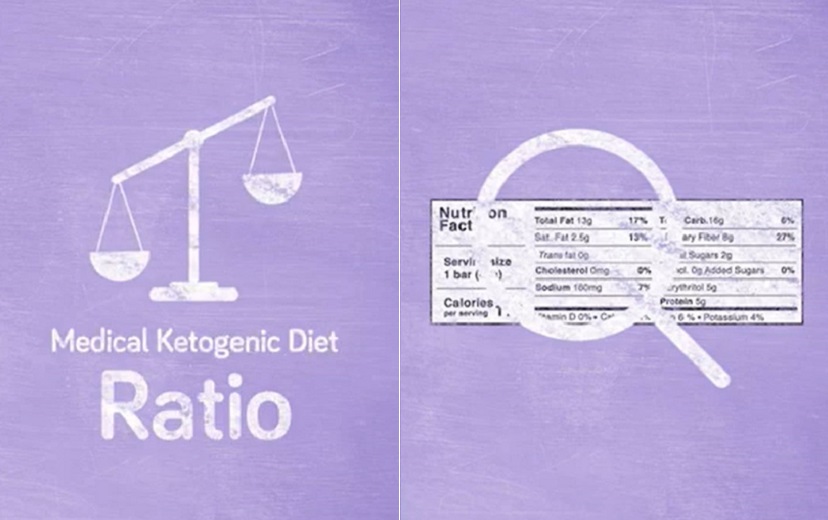Medical ketogenic diets are created using a ratio of grams of fat to grams of protein and carbohydrates combined. The higher the ratio, the more fat is consumed in the diet. Ketogenic diets have been used for over 100 years to help manage drug-resistant epilepsy*. Determining which ratio is appropriate to help you reduce seizures is dependent on several factors and must be discussed with a ketogenic healthcare team.
Learn more about medical ketogenic diet ratios by watching this short video from Zahava Turner, RD, CSP, LD, a ketogenic dietitian.
What Is a Medical Ketogenic Diet Ratio?
Video Transcript:
Hi! I’m Zahava! I’m a registered dietitian. Today I’m going to talk about the medical ketogenic diet ratio.
The medical ketogenic diet is designed by using a ratio of grams of fat to grams of protein and carbohydrates combined. The higher the ratio the more fat will be eaten in the diet and the increased likelihood of producing larger ketones. A typical medical ketogenic diet ratio is between a 3:1 and a 4:1 – which is 4 grams or 3 grams of fat for every 1 gram of protein and carbohydrate combined. The goal with this ratio is to promote ketosis while meeting protein requirements for growth. When following these ratios your diet will consist of 85-90% fat.
Lower ratios like a 1:1 and 2:1 allow for more carbohydrates and protein to be eaten but can produce fewer ketones. Each ingredient in the meal is weighed on a gram scale to ensure that the ratio that is prescribed is achieved. Your medical ketogenic diet team will evaluate and determine which ratio is appropriate.
Thanks for watching! Be sure to check our other videos on the medical ketogenic diet.
Classic Ketogenic Diet and Modified Atkins Diet
Two common variations of medical ketogenic diets include the classic ketogenic diet and the modified Atkins®** diet (MAD). The classic ketogenic diet is most strict and follows a 4:1 ratio, meaning there are four parts fat for every one part of protein and carbohydrate. MAD is less restrictive; it does not require the weighing of foods.
If you’re getting ready to begin a classic keto diet or MAD journey, check out these 2 videos from ketogenic dietitians, Vanessa Aldaz, MPH, RD, CDE and Stacey Bessone, RDN, LDN for helpful tips.
Tips for Starting a Classic Ketogenic Diet
Video Transcript:
Hey! I’m Vanessa! I’m a registered dietitian and today we’re going to go through 5 simple tips to help you optimize your success on the classic ketogenic diet.
- Don’t start the diet on your own! Get help and medical supervision from an expert team that includes a well-trained ketogenic registered dietitian (RD) to calculate your diet for your individualized needs.
- Talk about the medical ketogenic diet with your family and friends to get their full support.
- Stick to your ratio and meal plans provided, unless otherwise directed by your dietitian.
- Use a gram scale to weigh your foods. Precision is key for success on this diet. You may end up having multiple scales (one at home, a travel scale for eating out, and one at your relatives’ house)
- Don’t forget to take your supplements, including a complete multivitamin/mineral supplement, as directed by your healthcare team to ensure all of your nutrient needs are being met.
Adjusting to a new diet can be challenging but remember, you have a team supporting you along the way. Success is achieved by taking it one step at a time.
Thanks for watching! Be sure to check our other videos on the medical ketogenic diet.
Tips for Starting a Modified Atkins Diet
Video Transcript:
Hi! I’m Stacey! I’m a registered dietitian. Here are 5 simple tips to help you start on the Modified Atkins Diet for the management of intractable epilepsy.
- Always plan your meals for the day, dividing up your carbohydrates into those meals and snacks that best fit your eating habits. For example, if you are eating a 15 g carbohydrate diet per day and you don’t eat much for breakfast, maybe only use 2 grams of carb for your morning meal, leaving 10 grams of carb for both lunch and dinner as well as 3 grams for snacks.
- In the beginning it can be helpful to purchase frozen fruits & vegetables. The food label can help you navigate serving sizes, carbohydrate, and fiber amounts. This can help you get a good idea of what a serving is for the fresh version of the fruit and vegetable and will help you count carbs when there is no label.
- It is very important to add fat to every Feel free to experiment until you find combinations you enjoy. For example, adding cream sauces to proteins such as steak or chicken is a tasty way and fun way to get more fats into your diet. Adding a ketogenic formula once a day, is also an easy way to add fat to your diet.
- Drink plenty of water and remember to take your vitamin and mineral supplements recommended by your dietitian.
- If you are still hungry after a meal or during the day, you are probably not adding enough fat to your meals and snacks. Fat will keep you full and help your body make ketones. Sometimes making fat bombs and having those as a snack can help.
Thanks for watching! Be sure to check our other videos on the medical ketogenic diet.
Reading Food Labels
Successfully managing a ketogenic diet requires getting comfortable with reading food labels. Reading and understanding food labels can be overwhelming. Vanessa reviews food labels in this next video. She shows us how to make a food label simple to read by breaking them down into sections. Watch below.
Video Transcript:
Hi! I’m Vanessa. I’m a registered dietitian. Today we’re going to talk about How to read a food label when you are on a medical ketogenic diet. Food labels can be very overwhelming, so let’s break down how to read them.
- First, identify the serving size in grams. The numbers listed on the label relate to one serving size, which is not always the whole package. Feel free to weigh this amount on your gram scale for accuracy. Be mindful, one package can often contain more than one serving.
- Next find the calories: is this the right amount of calories you need from this food? This calorie amount is specific to the serving size.
- Now, identify in bold the total fat in grams. For this food, it is 13 g of fat.
- Identify in bold the total carbohydrates in grams and note underneath if any fiber is included. If yes, you may subtract this amount of fiber from your total carbs to get your net carbs. Keep an eye out for sugar alcohols. Examples of typical sugar alcohols on labels may be xylitol, sorbitol, erythritol, lactitol, etc.
- Now, identify the bolded total protein in grams. For this food, it is 5 g.
- If you are on the classic ketogenic diet, you’ll need to calculate the ratio of this food: total grams of fat divided by total grams of net carbs + PLUS total grams of protein. Here for example, it is a 1:1 ratio.
Finally, be careful with ready-to-eat foods and snacks labeled “ketogenic” or “keto-friendly” on the grocery shelves because most will NOT be at your prescribed ratio. They may still contain hidden carbohydrates and not enough fat to work well with your medical ketogenic diet.
Careful attention to the label is key for success!
Find our full range of ketogenic diet short videos here.
*Drug-resistant epilepsy, also known as intractable or refractory epilepsy, is when a patient continues to experience epileptic seizures after treatment with a at least 2 anti-epileptic medications.
**Atkins is a registered trademark of Atkins Nutritionals, LLC and not affiliated with Nutricia North America.
KetoCal® is a medical food for the dietary management of drug-resistant epilepsy and must be used under medical supervision.
Copyright 2024 Nutricia North America. All rights reserved. Brought to you by Nutricia North America.

